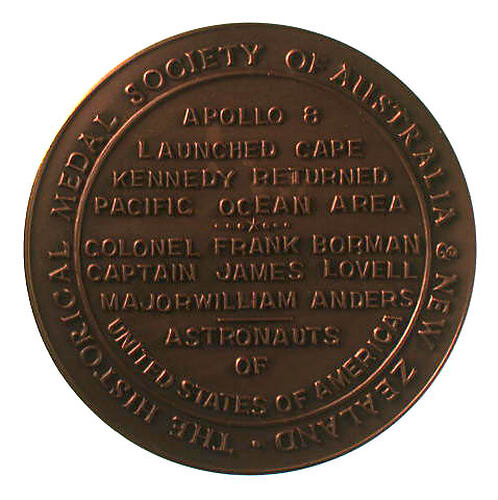Major General William Anders was born in Hong Kong on 17 October 17 1933. He received a bachelor of science degree from the United States Naval Academy in 1955. Anders was subsequently commissioned into the Air Force and served as a fighter pilot in the Air Defense Command. He was later responsible for technical management of nuclear power reactor shielding and radiation effects programs at the Air Force Weapons Laboratory, New Mexico. In 1962 he received a master of science degree in nuclear engineering from the Air Force Institute of Technology at Wright-Patterson Air Force Base, Ohio. He married Valerie E. Hoard of Lemon Grove, California. They had four sons and two daughters.
In 1964 Anders was chosen by the NASA as an astronaut with responsibilities for dosimetry, radiation effects and environmental controls. He became backup pilot for the Gemini XI, Apollo 11 flights, and joined the first lunar orbit mission in December 1968 as lunar module pilot for Apollo 8. From 1969 to 1973 he was Executive Secretary for the National Aeronautics and Space Council, which was responsible for developing policy options concerning aeronautical and space systems.
In 1973 he was appointed to the five-member Atomic Energy Commission, where he was head commissioner for all nuclear and non-nuclear power research and development. He was also US Chairman of the joint US/USSR technology exchange program for nuclear fission and fusion power, and first Chairman of the newly established Nuclear Regulatory Commission, responsible for nuclear safety and environmental compatibility. He was then appointed United States Ambassador to Norway, position he held until 1977.
After 26 years of Federal government service, Anders briefly served as a Fellow of the American Enterprise Institute, then joined the General Electric Company in September 1977 as Vice President and General Manager of the Nuclear Products Division. He was responsible for the manufacture of nuclear fuel, reactor internal equipment and control and instrumentation for GE boiling water reactors at facilities located in San Jose and Wilmington, as well as being responsible for the GE partnership arrangement with Chicago Bridge and Iron for the manufacture of large steel pressure vessels in Memphis, Tennessee. In 1979 completed the Harvard Business School's Advanced Management Program.
In 1980 Anders was appointed General Manager of the General Electric Aircraft Equipment Division with headquarters in Utica, New York. After four years he left to join Textron as Executive Vice President-Aerospace, moving to Senior Executive Vice President-Operations in 1986. He was also a consultant to the Office of Science and Technology Policy and was a member of the Defense Science Board amd the NASA Advisory Council. In 1990 Anders was made Vice Chairman of the General Dynamic Corporation for 1990, and the following year was made Chairman & Chief Executive Office. In 1993 he retired, but remained chair of the Board until 1994.
Anders is a retired Major General in the USAF Reserve.
Amongst the many commemorations of his achievements as an astronaut, in 1968 the Historical Medal Society of Australia & New Zealand issued a medal to commemorate the first manned lunar orbit flight in December 1968 (NU 23871). It named the crew: Frank Borman (commander), James A. Lovell (command module pilot and navigator) and William A. Anders (lunar module pilot).
References:
NASA website http://vesuvius.jsc.nasa.gov/er/seh/anders.htm, accessed 27 Nov 2003; http://www.jsc.nasa.gov/Bios/htmlbios/anders-wa.html, accessed 14 May 2010.
More Information
-
Keywords
-
Localities
-
Authors
-
Article types

